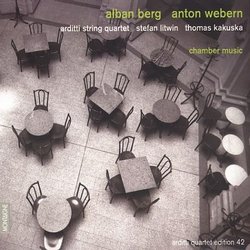An Enticing Taste of Early Berg and Webern
J Scott Morrison | Middlebury VT, USA | 12/28/2003
(4 out of 5 stars)
"The Arditti Quartet and friends performed this group of early Webern and Berg pieces for Sender Freies Berlin in 1994 and the enterprising French label, Naïve, has now issued it in their 8th CD of music from the Second Viennese School. It is a fascinating document largely because it contains very early works by those two composers written while (and shortly after) they spent several years under the tutelage of their fabled teacher, Arnold Schönberg, who insisted they master the processes of composition already formulated by predecessors like Brahms, Schumann and Wagner. The first piece here, Webern's 'Quintet for Strings and Piano, M. 118' (1907)--here the M. stands for the chronological listing catalog by American Webern scholar Hans Moldenhauer--is a one-movement work lasting fourteen minutes. Strangely (but understandably, considering how Webern's compositional style evolved) this is Webern's LONGEST piece. It is written in the convoluted hyperchromatic style, not yet atonal, reminiscent of his teacher's 'Verklärte Nacht,' and is a lush and lovely work with three discernible sections. There are some proto-Webernian touches including extremely specific and frequent dynamic markings, muted ponticello effects marked ppp and so on. But no one unfamilar with it would immediately connect it to Webern. Schönberg, Zemlinsky, Schreker yes, but not Webern. It's too prolix, too Romantic. But it is entirely entrancing. And it is, of course, played beautifully by the Arditti Quartet and pianist Stefan Litwin.Next comes 'Four Pieces for Violin and Piano, Op. 7,' written in 1910. By this point Webern's style had evolved and the three pieces (played by Irvine Arditti and pianist Litwin) are characteristically gnomic and extremely terse. It is interesting to note that Schönberg's pupils did not assign an opus number to anything they wrote until he gave his approval; obviously, by the time of these three miniatures, Schönberg had long-since given the nod. TWebern's 'Cello Sonata, M. 202' (1914) and the 'Three Pieces for Cello and Piano, Op. 11' (also 1914) were composed simultaneously and share thematic and procedural material. However, Op. 11 (the piece given an opus number by Webern) is much more clearly in his mature style and one has the sense that the Sonata was perhaps a study for the Three Pieces. The Three Pieces, very elliptical, very enigmatic, are also very refined and somehow more atmospheric. The hair-trigger performances are by Arditti cellist Rohan de Saram and pianist Litwin. Finally we have nine short pieces (1907-1908) by Berg for various chamber combinations. They are all student pieces and would not be amiss in an all-Brahms or all-Schumann concert. They are 'String Quartet Fugue,' 'String Quartet Variations on an Original Theme,' 'Sarabande,' 'Minuet in d minor,' 'Minuet in c minor,' 'Three String Quartet Variations on a Theme by Schumann,' 'Theme and Five Variations for Violin and Piano,' 'Fugue with Two Themes for String Quintet with Piano in Continuo Style,' and 'Adagio,' the latter for string quartet. They are all highly contrapuntal; indeed they were assigned for the purpose of giving Berg practice with contrapuntal techniques and even the two minuets implement canonic and fugal procedures. They are all played lovingly, even Romantically by the Arditti Quartet and Litwin. They are joined in the next to last piece, the String Quintet with Continuo Piano, by the Alban Berg Quartet's violist, Thomas Kakuska. The total timing for this disc is rather short--40'21"--but it will be invaluable for lovers of the music of Berg and Webern and for those who are interested in investigating the influence of Schönberg as teacher. Scott Morrison"

